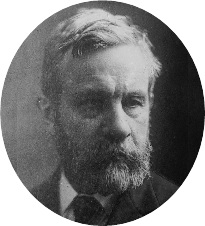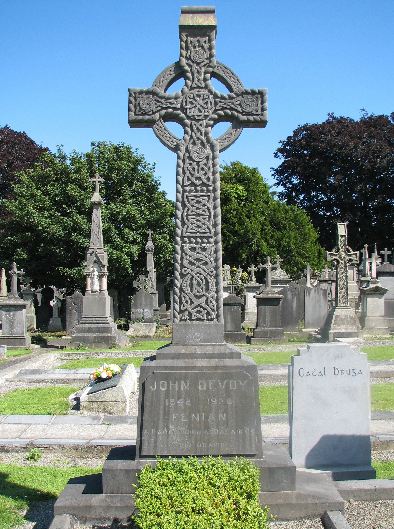|
John Devoy (1842-1928)
Fenian,
Political prisoner, Clan na Gael leader, Journalist
and Catalpa rescue director
 John
Devoy was born on September 3, 1842 at Greenhills
between Kill and Johnstown in
Co. Kildare into a
staunch nationalist family. His father was active in
nationalist circles in Kildare and his grandfather,
on his mother’s side, was a veteran of the 1798
Rising. John
Devoy was born on September 3, 1842 at Greenhills
between Kill and Johnstown in
Co. Kildare into a
staunch nationalist family. His father was active in
nationalist circles in Kildare and his grandfather,
on his mother’s side, was a veteran of the 1798
Rising.
At the onset of the famine in 1845 the family moved
to Dublin. Devoy received his education at the Christian Brothers O’Connell School on
North
Richmond Street and at the Model School in
Marlborough Street. After completing his education
he worked as a monitor (student teacher) at the
Model School in Strand Street.
He later attended classes the Catholic University
of Ireland in Dublin. He also attended Irish
classes where he came in contact with members of the
Irish Republican Brotherhood (IRB) whose aim was to end
British rule in Ireland and establish an Irish
Republic. When or how he became a member of the IRB
is unclear, but it can be safely assumed that it was
during that period of his life.
In 1861, Devoy joined T. D. Sullivan's National
Petition Movement and subsequently traveled to
France with a letter of introduction from Sullivan
to
John Mitchel. While in France he joined the
French Foreign Legion, ostensiblv to gain military
experience for the coming war with England. After
serving for a year on the Algerian front he returned
to Ireland where he was tasked with organizing the
IRB in the Naas area of Kildare.
In 1865 when many of the IRB leaders were arrested
James Stephens appointed Devoy chief organizer of
the IRB in the British army in Ireland. His task
was to recruit Irishmen in British regiments to join
the IRB and be ready to fight for Irish independence
when the time came. By the time he was arrested in
1866 his efforts and that of other recruiters had
given the IRB oath to as many as 15,000 men serving
in British regiments.
In November of 1865 after Stephens was arrested and
imprisoned in a remote wing of the heavily guarded
Richmond prison in Dublin, Devoy organized and
participated in Stephens' escape, which was
implemented flawlessly with the help of IRB
operatives
John J. Breslin and
Daniel Byrne who were
prison warders. Stephens hid out in Dunlin for a
number of months before fleeing to France to avoid
being recaptured.
In February of 1866, the IRB Council of War, aware
that the British knew of their plans from informers,
met to discuss plans for an immediate insurrection.
Devoy argued passionately for immediate action, as
he believed it was their best chance of success;
having an IRB force of 80,000 ready to strike.
Stephens, who as early as 1864 had called for an
insurrection, refused to go along, Stephen’s
refusal, was the beginning of the end of his
influence within the IRB. Colonel Thomas J. Kelly
replaced him as head of the IRB in December of 1866.
In February of 1866, Devoy was arrested at Pilsworth Pub in James Street, Dublin, while
attending an IRB meeting and interned in Mountjoy
Jail. He was charged with 'treason' and sentenced to
fifteen years penal servitude. Having served five
year of his sentence in Portland, Millbank and Chatam prisons he was released in the British
government's general amnesty of 1870. Behind the
"generosity" of the general amnesty was heavy
pressure by the U.S. government to free the scores
of former U.S. Army (and several Confederate Army)
personnel, including generals and colonels who had
gone to Ireland to participate in the uprising of
1867. The U.S. government intervention was the
result of Fenian instigated pressure, primarily in
letters from
John Savage to president
Ulysses S.
Grant.
Those released were required to leave the country
and not return until the term of their sentence had
expired. Devoy together with
Charles Uderwood
O'Connell, John McClure,
Jeremiah O'Donovan Rossa,
and Henry Mulleda came to America. The Cuba
Five so-called after the vessel they sailed on,
arrived in New York in January of 1871 to a hero's
welcome. They were also officially honored by a
resolution of the United States House of
Representatives.
After settling down in the New York, Devoy worked as
a journalist for the New York Herald. He also became
a member of the Clan na Gael (CNAG) whose mission
was to "complete and absolute independence of
Ireland from Great Britain, and the complete
severance of all political connections between the
two countries by unceasing preparation for armed
insurrection in Ireland".
He became the head of
the New York City chapter, which would grow to be
the largest in the US. He was the most vocal
advocate in seeking America’s help in achieving
"genuine democracy and authentic republicanism"
for
the Irish, nothing more or less what America
demanded of itself.
In 1875, in one of the boldest and most imaginative
exploits in Irish American history Devoy, John J. Breslin and other CNAG leaders approved a plan
devised by
John Boyle O'Reilly to rescue several
Fenian compatriots from their prison in Fremantle,
Australia. Breslin and Thomas Desmond who had
arrived in Australia towards the end of 1875, using
false identities, coordinated the ensuing escape. On
April 17, 1876 six Fenian prisoners were extracted
from the prison and placed aboard the whaling ship Catalpa captained by George Smith Anthony. Shortly
after the escapees boarded the Catalpa it was set
upon by a British naval cutter demanding their
surrender. In response, Captain Anthony ran up the
Stars and Stripes, challenging the cutter to fire
upon the American flag.
During a visit to
Ireland in 1879, Devoy met with Charles Kickham,
John O'Leary, leading figures of the IRB, and
Michael Davitt, the founder of the
Land League,
ostensibly to better align their effort to free
Ireland from the ravages of British imperialism.
Shortly after returning to the United States, with a
better understanding of the Irish perspective, he
entered into an informal agreement dubbed the “New
Departure,” with Michael Davitt and Charles Stewart
Parnell to create a united front that would include
a combination of physical force, agrarian agitation
and constitutional nationalism. In 1880, in support
of that agreement, Devoy together with Parnell and
Davitt embarked on a tour of the United States to
raise awareness and funds for the suffering tenant
farmers and the poor in Ireland.
In conjunction with
that tour, Parnell's sisters,
Fanny and
Anna and
other women activists, founded the Ladies Land
League here in the United States to raise awareness,
demonstrate solidarity and collect funds for
embattled farmer tenants in Ireland.
By 1880 fissures were
developing within CNAG. Seen by many as too
moderate, Devoy and Dr. Carroll lost their seats on
the Executive Committee at the 1881 convention in
Chicago as a result of delegate stacking by
Alexander Sullivan, Michael Boland and Denis Feeley
collectively known as the ‘Triangle’. For the next
eight years the organization was in turmoil with at
least three factions engaging in independent
operations including the Dynamite Campaign in
England and the bombing of the Welland Canal in Canada. To make matters worse Sullivan brought the
British spy, Henri Le Caron, into CNAG and, to cap
it all off, had Dr Carroll murdered. The ensuing
publicity surrounding the trial of Carroll's killers
exposed the inner workings of the CNAG.
In 1900, after the
murder trial of Carroll killers and the reign of the
'Triangle' ended, Devoy with the help of
Luke Dillon
and others managed to reconcile the various factions
on the basis of a firm commitment to military
struggle. From then on CNAG supported many of the
Irish nationalist projects including the
Gaelic Athletic Association, the Gaelic League and the Irish Volunteers and worked tirelessly to promote
anti-British feeling and prevent the entry of the
United States into the war on the side of Britain.
In 1914, Devoy took a leading role in promoting a
lecture tour of the United States by
Patrick Pearse
to save Saint Edna’s School from closure. That same
year he hosted
Roger Casement, later funding his
mission to Germany to procure arms and to recruit
Irish prisoners of war for service in the Irish
Volunteers
CNAG, under Devoy’s' leadership, was the chief
source of funds and arms for the 1916 Easter Rising.
Devoy was kept abreast of plans leading up to the
Rising, being in the confidence of
Thomas J. Clarke,
Padraic Pearse
and
Joseph M. Plunkett. He wanted to take part in the
Rising but could not get travel documents in time.
He addressed Dail Eireann in 1919, and considered
Eamonn De Valera to be an arrogant opportunist and
a dangerous demagogue with little or no respect for
or understanding of Irish-American politics.
Although gravely
disappointed with the Anglo-Irish Treaty he
reluctantly accepted it as a first step in a process
leading to a 32-county Irish Republic. Many believe
that
Devoy's reluctant acceptance of the Treaty was
influenced by his distrust of DeValera, who as
President of Dail Eireann was responsible for
selecting members of the delegation sent to London
to negotiate terms of the 'Treaty'. DeValera
gave the delegation authority to accept the terms
offered by the British without the prior approval of
Dail Eireann.
Devoy believed,
as did many others, that DeValera knew beforehand that the outcome would
be less that an All Ireland Republic and that
he, De Valera would term the outcome a 'Sellout'
to discredit members of the delegation he believed
would get in the way of his own future plans and
ambitions.
John Devoy passed away on September 29, 1928 in Atlantic City New Jersey. His body was returned to
Ireland for burial in Glasnevin Cemetery in Dublin.
Devoy's writing
included Land of Erin published in
1882, Recollections of an Irish Rebel was published
posthumously in 1929. He was editor of the Gaelic
American from 1903 until his death in 1928 .He was a
regular political contributor to the Irish-American
newspapers.
--------------------------------------
Contributed by Tomás Ó Coısdeablha
cemetery
Name:
Glasnevin
Cemetery
PHONE NO.
011
353 1 830-1133
ADDRESS: Finglas
Road, Glasnevin, Dublin 11, Ireland
HEADSTONE

|